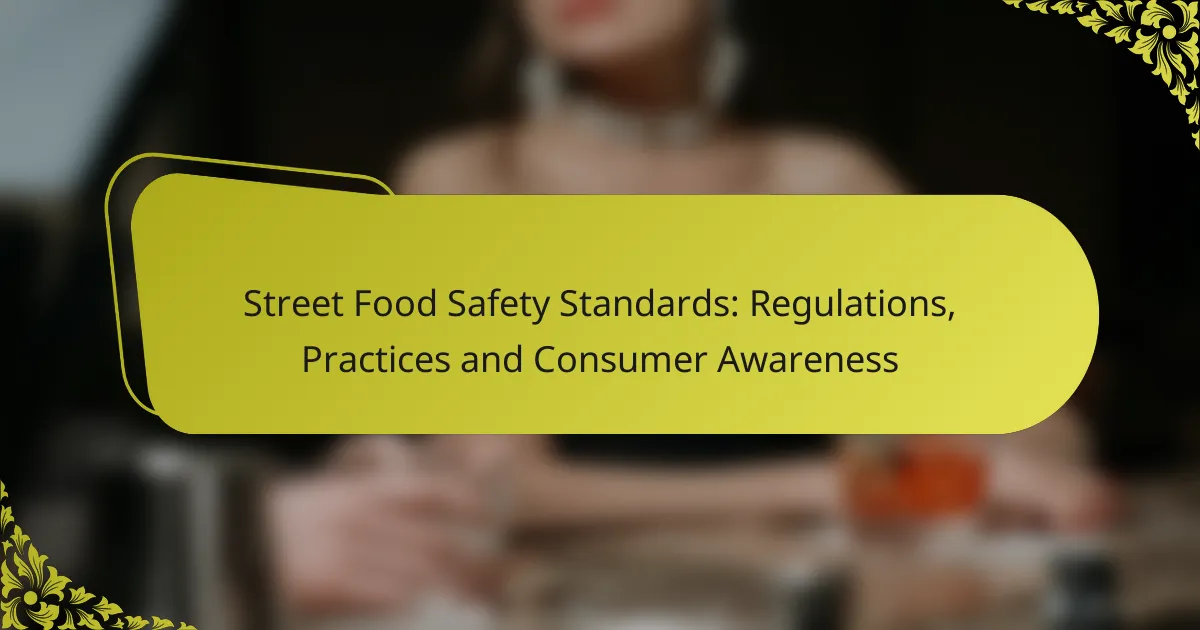Street food safety standards are essential for protecting consumers from foodborne illnesses and ensuring that vendors adhere to safe practices. These standards encompass food hygiene, temperature control, and regular inspections, which vary by region and local regulations. By understanding and implementing best practices, such as proper food handling and sanitation, both vendors and consumers can contribute to a safer street food environment.
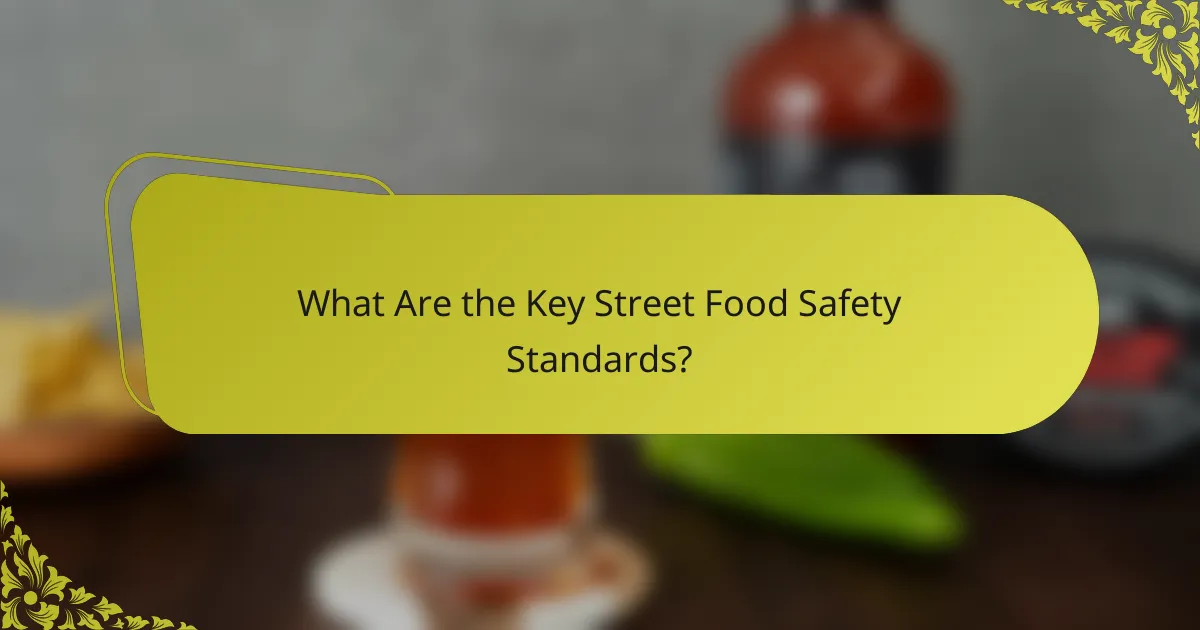
What Are the Key Street Food Safety Standards?
Key street food safety standards focus on ensuring food hygiene, proper temperature control, safe food handling, clear labeling, and regular inspections. These standards protect consumers from foodborne illnesses and ensure that street food vendors operate within safe and regulated practices.
Hygiene regulations
Hygiene regulations are essential for maintaining cleanliness in street food operations. Vendors must ensure that food preparation areas are sanitized, utensils are clean, and personal hygiene practices, such as handwashing, are strictly followed. Regular training on hygiene practices can help vendors comply with local health codes.
In many regions, vendors are required to wear gloves and hairnets while preparing food. They should also have access to clean water for washing hands and cleaning surfaces.
Temperature control requirements
Temperature control is critical to prevent food spoilage and bacterial growth. Hot foods should be kept at temperatures above 60°C (140°F), while cold foods must remain below 5°C (41°F). Vendors should use thermometers to regularly check food temperatures throughout the day.
Implementing a system for monitoring temperatures, such as using time stamps or logs, can help ensure compliance with safety standards. Vendors should also be aware of the “two-hour rule,” which states that perishable foods should not be left out at room temperature for more than two hours.
Food handling practices
Safe food handling practices are vital for minimizing contamination risks. Vendors should avoid cross-contamination by using separate cutting boards for raw and cooked foods. Additionally, they should ensure that food is cooked thoroughly to the appropriate internal temperatures.
Training staff on proper food handling techniques, such as using utensils instead of hands and keeping raw ingredients separate, can significantly reduce the risk of foodborne illnesses.
Labeling and allergen information
Clear labeling and allergen information are crucial for consumer safety. Vendors should provide information about ingredients and potential allergens, such as nuts, gluten, or dairy, to help customers make informed choices. This is especially important for individuals with food allergies or intolerances.
Labels should be easy to read and placed prominently on food items. Vendors can also benefit from training on how to communicate allergen information effectively to customers.
Inspection protocols
Regular inspections are a key component of street food safety standards. Local health authorities typically conduct inspections to ensure compliance with hygiene, temperature control, and food handling practices. Vendors should be prepared for inspections by maintaining proper records and adhering to regulations.
Establishing a routine for self-inspections can help vendors identify potential issues before official inspections occur. Keeping a clean and organized food cart or stall can also positively influence inspection outcomes.
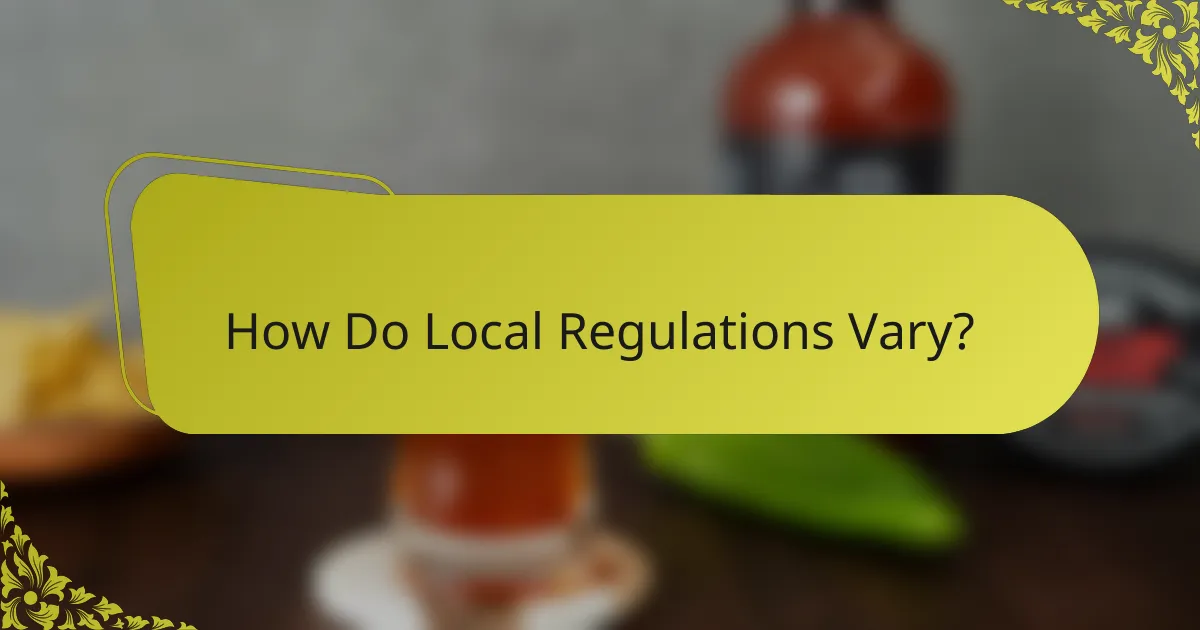
How Do Local Regulations Vary?
Local regulations for street food safety can differ significantly based on state, city, and regional health department guidelines. Understanding these variations is crucial for vendors and consumers to ensure compliance and safety in food handling practices.
State-specific regulations
Each state in the U.S. has its own set of regulations governing street food vendors, often outlined in food safety codes. These regulations can dictate everything from food storage temperatures to required permits and inspections. For instance, some states may require food handlers to obtain specific certifications, while others might have more lenient requirements.
Vendors should familiarize themselves with their state’s health department website to access the latest regulations and ensure compliance. Non-compliance can lead to fines or the revocation of permits, which can significantly impact business operations.
City ordinances
City ordinances can further refine state regulations, often addressing local health concerns or community standards. For example, cities may impose restrictions on where food trucks can operate, the types of food that can be sold, or specific sanitation practices that must be followed. These ordinances can vary widely even within the same state.
Street food vendors should check with local city councils or health departments to understand any additional requirements that may apply. Ignoring city-specific rules can result in penalties or business shutdowns.
Regional health department guidelines
Regional health departments often provide guidelines that encompass both state and city regulations, focusing on public health and safety. These guidelines typically include best practices for food handling, preparation, and storage, as well as recommendations for regular inspections.
Vendors should stay informed about any updates or changes to these guidelines, as they can impact operational practices. Regular training and adherence to these standards not only ensure compliance but also enhance consumer trust in the vendor’s food safety practices.
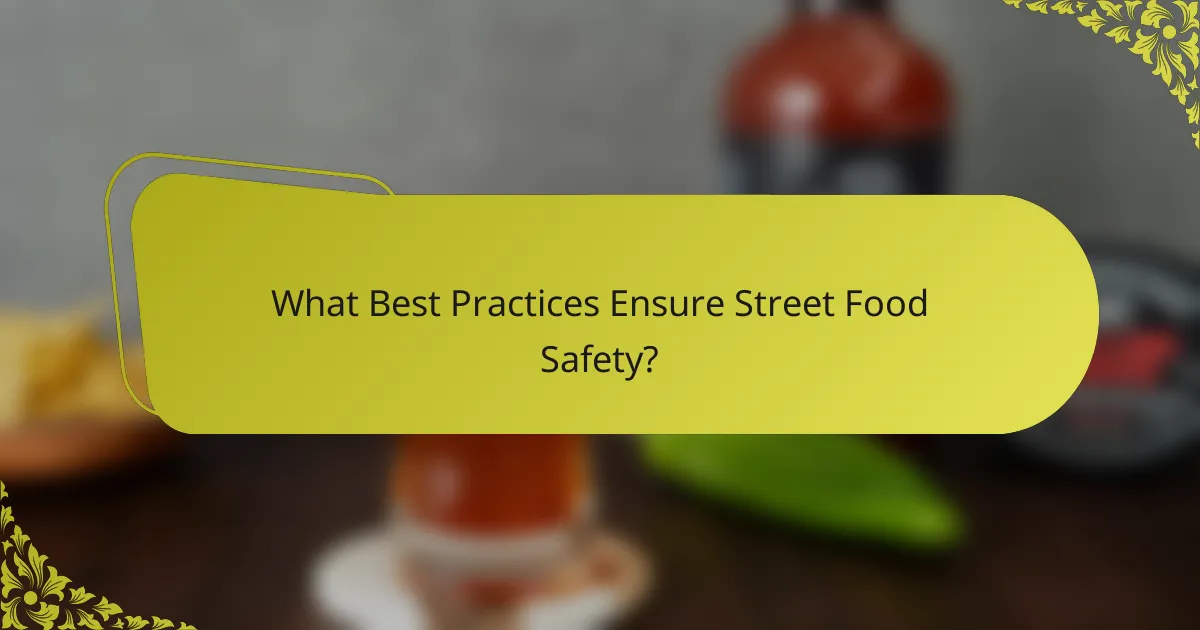
What Best Practices Ensure Street Food Safety?
Best practices for ensuring street food safety include regular training for vendors, safe food storage techniques, and strict sanitation protocols. These measures help minimize health risks and enhance consumer confidence in street food offerings.
Regular training for vendors
Regular training for street food vendors is essential to maintain high safety standards. Vendors should be educated on food handling, hygiene practices, and local health regulations. This training can take the form of workshops, online courses, or hands-on demonstrations.
Additionally, ongoing education helps vendors stay updated on best practices and emerging food safety trends. Regular assessments can ensure that vendors apply what they learn in their daily operations, reinforcing the importance of food safety.
Use of safe food storage techniques
Safe food storage techniques are critical in preventing foodborne illnesses. Vendors should store perishable items at appropriate temperatures, typically below 5°C (41°F), to inhibit bacterial growth. Using insulated containers and ice packs can help maintain safe temperatures during transport.
It is also important to keep raw and cooked foods separate to avoid cross-contamination. Utilizing color-coded storage containers can assist vendors in managing food safety effectively.
Implementation of sanitation protocols
Implementing sanitation protocols is vital for maintaining a clean food preparation environment. Vendors should regularly clean and sanitize surfaces, utensils, and equipment to eliminate harmful pathogens. A simple checklist can help ensure that all sanitation tasks are completed consistently.
Handwashing stations with soap and clean water should be readily available for vendors and staff. This practice not only promotes hygiene but also reassures customers about the safety of the food they consume.

How Can Consumers Ensure Their Safety?
Consumers can ensure their safety by being vigilant about the vendors they choose, understanding food preparation practices, and asking relevant questions about food sourcing. Taking these steps helps mitigate risks associated with street food consumption.
Identifying safe vendors
To identify safe vendors, look for those with a clean and organized setup. Vendors who maintain hygiene, wear gloves, and have proper food storage are generally more reliable.
Check for local health department ratings or certifications displayed prominently. A vendor with a good rating is more likely to adhere to safety standards.
Understanding food preparation signs
Food preparation signs can indicate the safety of the food being served. Fresh ingredients, visible cooking processes, and proper temperature control are key indicators of safe food handling.
Be cautious of foods that have been sitting out for extended periods or are not kept at appropriate temperatures. If food looks unappetizing or smells off, it’s best to avoid it.
Asking questions about food sourcing
Asking vendors about their food sourcing can provide insight into the quality and safety of the ingredients. Inquire where they obtain their produce and meats, and whether they follow local sourcing guidelines.
Vendors who are transparent about their suppliers and practices are more likely to prioritize food safety. Don’t hesitate to ask about how they handle food allergies or dietary restrictions as well.

What Are the Consequences of Non-Compliance?
Non-compliance with street food safety standards can lead to severe health risks for consumers, legal repercussions for vendors, and long-lasting damage to business reputations. Understanding these consequences is crucial for both food vendors and consumers to ensure safety and compliance.
Health risks to consumers
When street food vendors fail to adhere to safety standards, consumers may face significant health risks, including foodborne illnesses. Common pathogens such as Salmonella, E. coli, and Listeria can thrive in improperly stored or handled food, leading to symptoms ranging from mild gastrointestinal upset to severe illness.
To mitigate these risks, vendors should ensure proper food handling practices, such as maintaining appropriate cooking temperatures and avoiding cross-contamination. Consumers should be aware of the cleanliness of food stalls and the vendor’s food handling practices before making a purchase.
Legal penalties for vendors
Vendors who do not comply with food safety regulations may face various legal penalties, including fines, temporary closures, or even permanent revocation of their food service licenses. The severity of these penalties often depends on the nature of the violation and local regulations.
For example, in the United States, fines can range from hundreds to thousands of dollars for serious violations. Vendors should regularly review local health codes and ensure compliance to avoid these legal consequences.
Impact on business reputation
Failure to comply with safety standards can severely damage a vendor’s business reputation. Negative reviews and word-of-mouth can spread quickly, leading to a decline in customer trust and sales. A single incident of food poisoning linked to a vendor can result in long-term reputational harm.
To protect their reputation, vendors should prioritize food safety, maintain high hygiene standards, and actively engage with customers to build trust. Regular training for staff on food safety practices is also essential to uphold a positive image in the community.
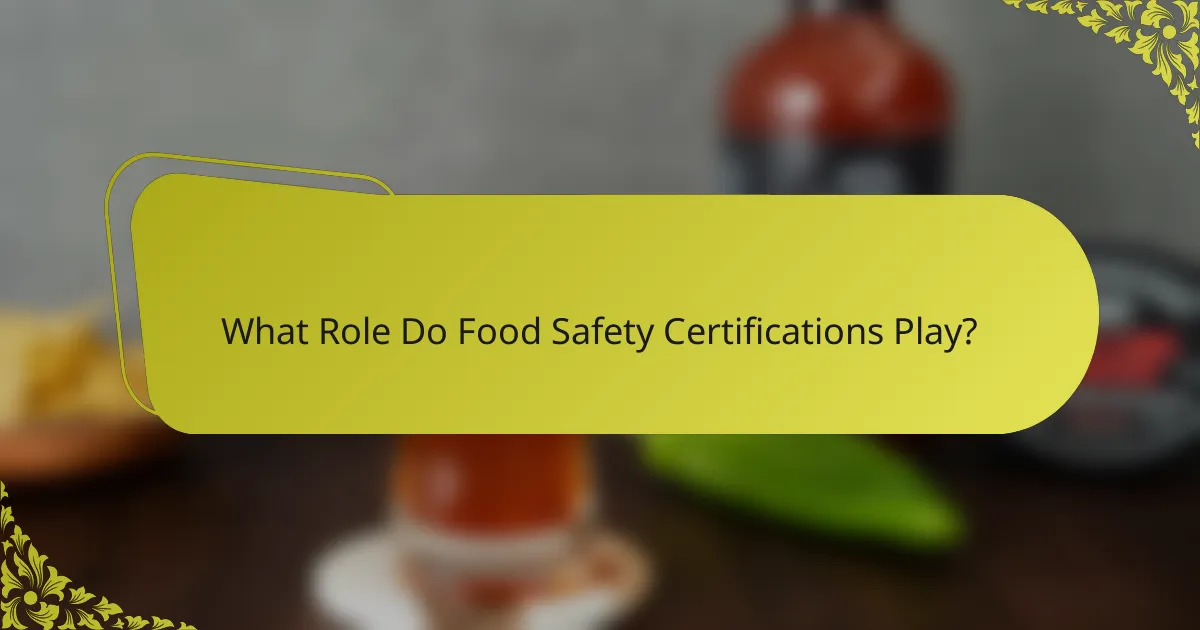
What Role Do Food Safety Certifications Play?
Food safety certifications are essential for ensuring that street food vendors meet specific hygiene and safety standards. These certifications help consumers identify safe food options and encourage vendors to maintain high-quality practices.
Types of Food Safety Certifications
There are several types of food safety certifications, including local health department permits, ServSafe, and Hazard Analysis Critical Control Point (HACCP) certifications. Each certification has its own requirements and focuses on different aspects of food safety, such as proper food handling, sanitation, and temperature control.
For instance, a ServSafe certification typically involves training on food safety best practices and may require passing an exam. In contrast, HACCP focuses on identifying and managing potential hazards in food production processes.
Benefits of Food Safety Certifications
Food safety certifications provide numerous benefits for both vendors and consumers. For vendors, these certifications can enhance credibility and attract more customers who prioritize safety. Consumers can feel more confident when purchasing food from certified vendors, knowing that they adhere to recognized safety standards.
Additionally, certifications can help vendors avoid legal issues and fines associated with food safety violations, as they demonstrate a commitment to maintaining safe food practices.
How to Verify Food Safety Certifications
To verify a street food vendor’s food safety certification, consumers can ask to see the certificate displayed prominently at their stall. Many local health departments also maintain online databases where the public can check the status of food safety permits.
It’s advisable to look for certifications that are current and issued by reputable organizations. If a vendor cannot provide proof of certification, it may be best to choose another option.
